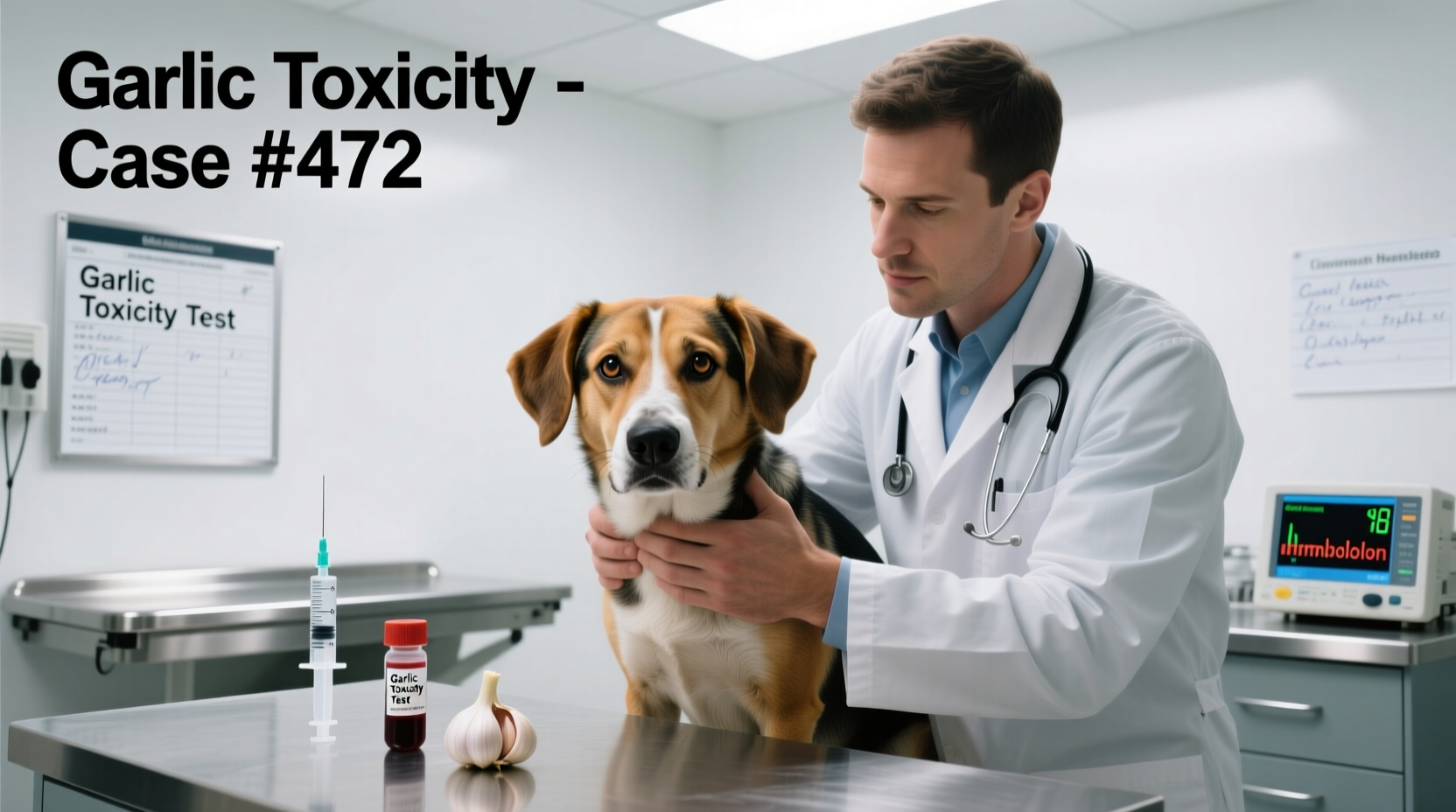Many dog owners wonder if cooked garlic is safer than raw for their pets. The truth is both forms pose significant health risks. While some natural remedy advocates claim small amounts of garlic offer health benefits for dogs, veterinary toxicology research consistently shows no safe dosage exists for canine consumption.
Why Garlic Remains Dangerous After Cooking
Cooking doesn't neutralize garlic's toxic compounds. The primary danger comes from N-propyl disulfide and other thiosulfates that oxidize hemoglobin in red blood cells. This damage causes:
- Hemolysis (rupturing of red blood cells)
- Reduced oxygen transport capacity
- Potentially fatal hemolytic anemia
- Organ damage from toxin buildup
According to the Merck Veterinary Manual, Allium species (including garlic, onions, and chives) remain toxic regardless of preparation method. The cooking process may alter flavor and concentration but doesn't eliminate the harmful compounds.
| Preparation Method | Toxicity Level | Key Risk Factors |
|---|---|---|
| Raw garlic | High | Immediate exposure to full concentration of thiosulfates |
| Cooked garlic | High | Toxic compounds remain active; often consumed in larger quantities when mixed with food |
| Garlic powder | Very High | Concentrated form; 1 tsp powder = 1 entire bulb of fresh garlic |
| Garlic supplements | Extreme | Unregulated concentrations; often marketed as "safe" for dogs |
How Much Garlic Is Dangerous for Dogs?
The toxic threshold varies by dog size and health status. Research from the Veterinary Partner indicates:
- Minimum toxic dose: 15-30 grams of garlic per kilogram of body weight
- Single clove risk: One average garlic clove (3-7g) could harm small dogs (<15 lbs)
- Accumulated exposure: Repeated small amounts over days increase toxicity risk
Japanese breeds like Shiba Inus and Akitas show heightened sensitivity to Allium toxicity. Dogs with pre-existing anemia or G6PD deficiency face significantly higher risks.

Symptoms of Garlic Poisoning in Dogs
Symptoms often appear 24-72 hours after ingestion as damaged red blood cells accumulate. Early signs include:
- Vomiting and diarrhea
- Abdominal pain
- Loss of appetite
- Excessive drooling
Advanced symptoms indicating severe toxicity:
- Pale or yellow-tinged gums
- Rapid breathing and heart rate
- Dark orange or red urine
- Weakness and collapse
- Jaundice (yellowing of eyes/skin)
The ASPCA Animal Poison Control Center reports that garlic toxicity cases often require hospitalization, with symptoms sometimes appearing days after ingestion due to cumulative red blood cell damage.
Immediate Actions If Your Dog Eats Garlic
If your dog consumes garlic, follow these evidence-based steps:
- Calculate exposure: Estimate how much garlic was consumed (fresh weight or equivalent)
- Contact emergency vet: Call immediately—even if no symptoms appear
- Do NOT induce vomiting: Unless specifically instructed by veterinary professionals
- Preserve evidence: Save packaging or remaining food for identification
- Monitor symptoms: Watch for early signs over the next 72 hours
Treatment typically involves intravenous fluids, oxygen therapy, and in severe cases, blood transfusions. The American Kennel Club notes that early intervention significantly improves recovery outcomes.
Safe Alternatives for Canine Health
Many dog owners seek garlic for purported health benefits like flea prevention or immune support. Safer alternatives include:
- Flea prevention: Veterinarian-approved topical treatments
- Digestive health: Pumpkin puree (plain, unsweetened)
- Immune support: Blueberries and broccoli (in appropriate portions)
- Breath freshening: Dental chews approved by the VOHC (Veterinary Oral Health Council)
Always consult your veterinarian before introducing new foods or supplements to your dog's diet. The FDA warns that many "natural" canine supplements lack proper safety testing and regulation.
Common Misconceptions About Garlic and Dogs
Despite persistent myths, veterinary science confirms several critical facts:
- "Cooking makes garlic safe": Heat doesn't destroy thiosulfate compounds
- "Small amounts are beneficial": No scientific evidence supports health benefits outweighing risks
- "Only raw garlic is dangerous": All Allium family members (onions, chives, leeks) pose similar risks
- "Organic garlic is safe": Natural origin doesn't eliminate toxicity
The American Veterinary Medical Association emphasizes that food safety for pets requires different standards than human consumption, as canine metabolism processes certain compounds differently.
When Garlic Exposure Might Be Less Dangerous
Context matters when assessing risk. The following scenarios may present lower immediate danger (though veterinary consultation remains essential):
- Large breed dogs consuming minimal amounts (e.g., one lick of garlic butter)
- Single exposure well below toxic threshold calculations
- Immediate veterinary intervention within 2 hours of ingestion
However, cumulative exposure from repeated small amounts remains dangerous. Dogs with pre-existing conditions like anemia or kidney disease face heightened risks even at lower exposure levels.
Can dogs eat any amount of cooked garlic safely?
No amount of cooked garlic is considered safe for dogs. While larger dogs might tolerate minimal accidental exposure without immediate symptoms, there is no established safe threshold. The compounds causing hemolytic anemia accumulate with repeated exposure, making even small amounts potentially dangerous over time.
How long after eating garlic will dogs show symptoms?
Symptoms typically appear 24-72 hours after ingestion as damaged red blood cells accumulate. Early signs include vomiting and lethargy, while advanced symptoms like pale gums and dark urine may take several days to manifest. In some cases, symptoms don't appear until significant red blood cell damage has occurred.
What should I do if my dog ate garlic bread?
Contact your veterinarian immediately. Calculate how much garlic was likely consumed (garlic bread typically contains 1-3 cloves per serving). Do not induce vomiting unless specifically instructed. Monitor for symptoms over the next 72 hours, even if your dog seems fine initially, as garlic toxicity symptoms often appear days later.
Are some dog breeds more sensitive to garlic toxicity?
Yes, Japanese breeds including Shiba Inus and Akitas show increased sensitivity to Allium toxicity. Dogs with pre-existing anemia, kidney disease, or G6PD deficiency also face higher risks. Smaller dog breeds naturally reach toxic thresholds with smaller amounts of garlic due to their body weight.
Is garlic powder more dangerous than fresh garlic for dogs?
Yes, garlic powder is significantly more concentrated and dangerous. One teaspoon of garlic powder equals approximately one entire bulb of fresh garlic. This concentrated form makes accidental toxic exposure more likely, especially when found in commercial dog foods or supplements marketed as "natural" health products.











 浙公网安备
33010002000092号
浙公网安备
33010002000092号 浙B2-20120091-4
浙B2-20120091-4